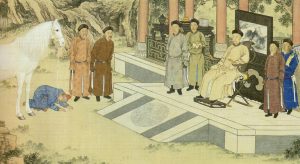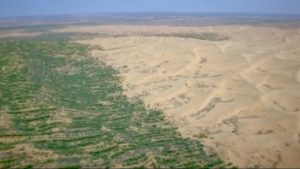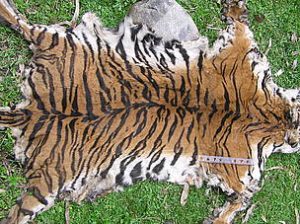The Effect Western Han Migration Had on the Environment
D. Gong
Introduction
Throughout China’s history, it has always seemed to have a large diverse population of different Chinese. However, no matter which ethnic Chinese is in control, there are always seems to be the common problem of migration. However, the movements of one group, the Han, whom migrated multiple times throughout the rule of the Qing dynasty was relatively well documented and shows a shocking discovery. The constant migrating westward into un-conquered land paid an appalling toll on the surrounding environments. Those pushing into the unsettled lands devastated the landscape in a thirst for natural resources such as timber/lumber, agriculture, mineral and animal. Additionally, programs put into effect by the government seemed to decrease the time it took to ruin the rich environments. Some of these programs include massive lumber collection and creating growing crops on bad loose soil. Additionally, with the destruction of so many habitats, many species became endangered. This page serves to take a deeper look into the various environmental damage the Han migration westward is responsible for.
Background
The most important piece of general background knowledge is that the Han were migrating westward into Xinjiang where they settled in the Gansu and Shaanxi regions. These locations are in the north-western areas of China and were unsettled lands before the migration of the Han. Once the settled, the Han noticed a change in the climate as they began reshaping the land and harvesting its resources. This caused them to have to migrate once again which created a constant cycle in which the environment suffered. Additionally, the rising population of China at the time increased the demand for natural resources. This cause the increase of certain industries, like agriculture, to be worked on at a larger scale. These are just some of the surface level problems and effects which the Han had to face.
The Effect Westward Expansion had on Minorities
Minorities during the western expansion into the frontier had a blended outcome during the Qing dynasty. The Chinese government would constantly have military expeditions to the borders of their territory, mainly to keep military communities like the Mongols in check. Internal migration of the tribal minorities added to the Qing empire would cause distress as the Manchu provinces disliked the tribal and spiritual traditions they had brought. Lastly, if a group of minority people wanted to trade with China, they would need to visit the emperor as a vassal and pay tribute to him. This was known as the tributary system of foreign relations and was used all throughout Chinese history to deal with foreigners.

How the Military plays a Role in Agriculture
Due to the intervention of the military, the amount of land cultivation was three times as much area as was cultivated before the Qing Dynasty. This happened primarily in the North-western Gansu region of China. The increasing population was in a dire need of food, so much so that food shortages and riots were known to occur. Due to this shortage, the military enacted an agricultural system called the “Tuntian System.” This system was the gifting of a piece of land to soldiers or civilians in order for them to grow crops. Additionally, tools, seeds, and oxen were provided by the government with the inclusion of a small fee. However, even though it sounds like a fair system, the farmers were to give up half of the crops yielded. This was system was especially strict due to the strategic location of the Gansu Province. Here, the military seemed in control with a third of the land going to military garrisons and the rest being cultivated by around 3 million Han Chinese. Not only was this system unfair to the people, it wreaked havoc on the environment. Not only was the soil in the region loose and not ideal agriculture soil, the farming would commence thus increasing the desertification, the deteriorating water, and soil erosion. Additionally, this system contributed to deforestation as it resulted in the decrease of the Red Willow Tree.

Deforestation
Military and agricultural demands were some of the driving factors of deforestation in Western China. Although Military and agricultural demands were some of the driving factors of deforestation mentioned in the previous section on Agriculture, this is the reason as to why it will not be critically reviewed in regards to deforestation. That being said, although deforestation has been a common problem in the past, the Qing dynasty had the most significant contribution to the steep decrease in forests. One of the largest results of deforestation was the result of the war in which the Taiping Rebellion (Taping Civil war) was being fought. The necessity for the collection of fuel woods, and timber were also driving factors of the reducing forests. Although timber used bigger logs for construction and building, fuel wood was a big factor into the reduction of forests as any sort of wood could act as firewood. These two factors combined would result in the destruction of almost all forests in Northern-China. It is important to remember that none of this would have happened without the western migration of the Han Chinese into the previously unsettled lands.

Map
This is a map which shows the boundries of the regions of Xinjiang, Gansu, and Shasnxi. Each of these locations were heavily impacted by the environmental changes brought on by the Han migration into the western frontier. This map shows the massive distance which the migration had influenced.
The Effect on the Wildlife
If the previous two topics were any hint as to what happened to the wildlife in China, then one could guess the native species did not fare much better. The main reason for the decline in the wildlife population was deforestation and its direct influence on the daily life of certain animals. Deforestation destroys the habitat which animals thrive, kills off the food of some creatures, and force predators to new habitats which will throw the ecosystem into chaos resulting in more deaths. A prime example of the effect on deforestation had on wildlife was the Changbai Mountain region which was untouched before the Qing Dynasty and after resulted in the loss of a large amount of animals such as the Asian Elephant and South China Tiger. Although not in Qing Dynasty time period, it is known that today 40% of animals and 70% of the plant species in China are endangered. It is worth noting since the Qing was the last great Imperial Chinese Government as it shows the direct effect on non-human life in China.

Conclusion
In retrospect, the effects that the Han migration into the west seem to be direct causes of the environmental catastrophe which embodies China today. Obviously, there are newer more pollutant technology used today in Chinese factories, cities, and living spaces. Especially during the Qing Dynasty, where the population grew at an astounding rate, it has been difficult to keep a good balance between environmental consciousness and supplying the entire population with enough food and supplies to live with. That being said, the harvested resources like timber directly led to the large endangered population in China today. Also, a lot of the agriculture which was done depleted the soil and resulted in the desertification of many landscapes. Overall, although some progress has been made in restoring China, the environmental destruction and degradation caused by humans should never be forgotten again.
Works cited
- Li, Yanpeng, Quansheng Ge, Huanjiong Wang, and Zexing Tao. “Climate Change, Migration, and Regional Administrative Reform: A Case Study of Xinjiang in the Middle Qing Dynasty (1760–1884).” Science China Earth Sciences 60, no. 7 (2017): 1328-337.
- Lavely, William, and R. Bin Wong. “Revising the Malthusian Narrative: The Comparative Study of Population Dynamics in Late Imperial China.” The Journal of Asian Studies57, no. 3 (1998): 714. doi:10.2307/2658739
- Tilman, D. “Global Environmental Impacts of Agricultural Expansion: The Need for Sustainable and Efficient Practices.” Proceedings of the National Academy of Sciences 96, no. 11 (1999): 5995-6000.
- Liu, Ts’Ui-Jung, and I-Chun Fan. “The Tuntian System in Xinjiang under the Qing Dynasty: A Perspective from Environmental History.” International Review of Environmental History (2016). doi:10.22459/ireh.02.2016.04.
- Zhao, Zhen. “Agricultural Reclamation Policy and Environmental Changes in the Northwest China during the Qing Dynasty.” Frontiers of History in China, no. 2 (2006): 276-91.
- Zhang, Yaoqi. “Deforestation and Forest Transition: Theory and Evidence in China.” World Forests World Forests from Deforestation to Transition?, 2000, 41-65.
- Rawski, Thomas G., and Lillian M. Li. Chinese History in Economic Perspective 102. Taipei: SMC Publishing, 1993, 102.
- Wikramanayake ED, Dinerstein E, Robinson JG et al. (1999). Where can tigers live in the future? A framework for identifying high-priority areas for the conservation of tigers in the wild. In: Seidensticker J, Christie S, Jackson P, eds. Riding the Tiger: Tiger Conservation in Human-Dominated Landscapes. Cambridge University Press, Cambridge, pp. 255–72.
- Zhang, Yaoqi. “Deforestation and Forest Transition: Theory and Evidence in China.” World Forests World Forests from Deforestation to Transition?, 2000, 41-65.
- Marks, Robert. 2017. China: an Environmental History. 2nd ed. Lanham: Maryland. Ch. 1
- Silbergeld, Jerome, and Evelyn S. Rawski. “China.” Encyclopædia Britannica, Encyclopædia Britannica, Inc., 30 Apr. 2019
